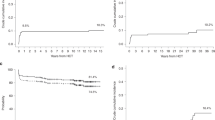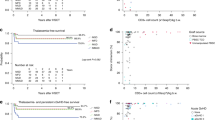Abstract
From August 1992 to August 1999, 44 patients received allogeneic haematopoietic stem cell transplantation in a single institution. The donors were HLA-identical siblings except for one who was a phenotypically matched father. Thirty-eight patients received bone marrow stem cells and the others received peripheral blood stem cells or umbilical cord blood (UCB). The mean age at transplant was 10.7 ± 5.1 years, ranging from 1.8 to 21 years. Patients received busulphan (16 mg/kg) and cyclophosphamide (150 to 200 mg/kg) as conditioning, and antithymocyte globulin was given to 42 patients to prevent graft rejection. All had engraftment except a patient who received a UCB transplant. Four patients died from early treatment-related mortality, and one died from interstitial pneumonitis 3 months after transplant. Two patients developed secondary graft rejection and both received a second transplant. Thirty-eight patients survived and all except one were transfusion independent. The 5-year overall and event-free survival rates were 86% and 82%, respectively. By multivariate stepwise Cox proportional hazard analyses, severe veno-occlusive disease (VOD) of liver and Pesaro class 3 features were the significant factors associated with survival. Patients aged more than 11 years were more inclined to develop VOD. In conclusion, haematopoietic stem cell transplantation should be performed early if an HLA identical sibling is available.
Bone Marrow Transplantation (2002) 29, 101–105. doi:10.1038/sj.bmt.1703340
This is a preview of subscription content, access via your institution
Access options
Subscribe to this journal
Receive 12 print issues and online access
$259.00 per year
only $21.58 per issue
Buy this article
- Purchase on Springer Link
- Instant access to full article PDF
Prices may be subject to local taxes which are calculated during checkout

Similar content being viewed by others
References
Lau YL, Chan LC, Chan YYA et al. Prevalence and genotypes of α- and β-thalassemia carriers in Hong Kong – implications for population screening New Engl J Med 1997 336: 1298 1301
Modell B, Khan M, Darlison M . Survival in β-thalassaemia major in the UK: data from the UK Thalassaemia Register Lancet 2000 355: 2051 2052
Lucarelli G, Galimberti M, Giardini C et al. Bone marrow transplantation in thalassemia. The experience of Pesaro Ann NY Acad Sci 1998 850: 270 275
Walters MC, Sullivan KM, O'Reilly RJ et al. Bone marrow transplantation for thalassemia. the USA experience Am J Pediatr Hematol Oncol 1994 16: 11 17
Roberts IAG, Darbyshire PJ, Will AM . BMT for children with β-thalassemia major in the UK Bone Marrow Transplant 1997 19 (Suppl. 2): 60 61
Lin KH, Lin KS . Allogeneic bone marrow transplantation for thalassemia in Taiwan: factors associated with graft failure Am J Pediatr Hematol Oncol 1989 11: 417 423
Lucarelli G, Galimberti M, Polchi P et al. Bone marrow transplantation in patients with thalassemia New Engl J Med 1990 332: 417 421
Li CK, Lai DH, Shing MMK et al. Early iron reduction programme for thalassaemia patients after bone marrow transplantation Bone Marrow Transplant 2000 25: 653 656
Olivieri NF . The β-thalassemias New Engl J Med 1999 341: 99 109
Li K, Li CK, Wong RPO et al. Transfusion-related immunomodulation in Chinese children with thalassaemia Vox Sang 1997 73: 167 173
Lucarelli G, Galimberti M, Polchi P et al. Marrow transplantation in patients with thalassemia responsive to iron chelation therapy New Engl J Med 1993 329: 840 844
Lucarelli G, Clift RA, Galimberti M et al. Bone marrow transplantation in adult thalassemic patients Blood 1999 93: 1164 1167
Angelucci E, Brittenham GM, McLaren CE et al. Hepatic iron concentration and total body iron stores in thalassemia major New Engl J Med 2000 343: 327 331
Slattery JT, Sanders JE, Buckner CD et al. Graft-rejection and toxicity following bone marrow transplantation in relation to busulfan pharmacokinetics Bone Marrow Transplant 1995 16: 31 42
Li CK, Yuen PMP, Wong R et al. Busulphan level and early mortality in thalassaemia patients after BMT Bone Marrow Transplant 1999 23: 307 310
Lucarelli G, Clift RA, Galimberti M et al. Marrow transplantation for patients with thalassemia: results in class 3 patients Blood 1996 87: 2082 2088
Solh H, Rao K, da Cunha AM et al. Engraftment failure following bone marrow transplantation in children with thalassemia major using busulfan and cyclophosphamide conditioning Pediatr Hematol Oncol 1997 14: 73 77
Reverberi R, Menini C . Clinical efficacy of five filters specific for leukocyte removal Vox Sang 1990 58: 188 191
Andreani M, Manna M, Lucarelli G et al. Persistence of mixed chimerism in patients transplanted for the treatment of thalassemia Blood 1996 87: 3494 3499
Andreani M, Nesci S, Lucarelli G et al. Long-term survival of ex-thalassemic patients with persistent mixed chimerism after bone marrow transplantation Bone Marrow Transplant 2000 25: 401 404
Weinberg RS, Vlachos A, Najfeld V et al. Disparate lympho–erythroid donor to recipient chimaerism in a beta degrees-thalassaemia bone marrow transplant recipient with red cellindices indicative of apparent full engraftment Br J Haematol 1997 99: 61 63
Aker M, Kapelushnik J, Pugatsch T et al. Donor lymphocyte infusions to displace residual host hematopoietic cells after allogeneic bone marrow transplantation for β-thalassemia major J Pediatr Hematol Oncol 1998 20: 145 148
Acknowledgements
This work was supported in part by The Hong Kong Paediatric Bone Marrow Transplant Fund of the Chinese University of Hong Kong. We thank the nursing staff for providing dedicated care to the BMT patients.
Author information
Authors and Affiliations
Rights and permissions
About this article
Cite this article
Li, C., Shing, M., Chik, K. et al. Haematopoietic stem cell transplantation for thalassaemia major in Hong Kong: prognostic factors and outcome. Bone Marrow Transplant 29, 101–105 (2002). https://doi.org/10.1038/sj.bmt.1703340
Received:
Accepted:
Published:
Issue Date:
DOI: https://doi.org/10.1038/sj.bmt.1703340
Keywords
This article is cited by
-
Hematopoietic stem cell transplantation for children with β-thalassemia major: multicenter experience in China
World Journal of Pediatrics (2018)
-
Diagnosis and severity criteria for sinusoidal obstruction syndrome/veno-occlusive disease in pediatric patients: a new classification from the European society for blood and marrow transplantation
Bone Marrow Transplantation (2018)
-
Efficiency of allogeneic hematopoietic SCT from HLA fully-matched non-sibling relatives: A new prospect of exploiting extended family search
Bone Marrow Transplantation (2015)
-
HLA-matched sibling stem cell transplantation in children with β-thalassemia with anti-thymocyte globulin as part of the preparative regimen: the Greek experience
Bone Marrow Transplantation (2012)
-
Child abuse: an indirect consequence of failure of bone marrow transplantation
Bone Marrow Transplantation (2005)



